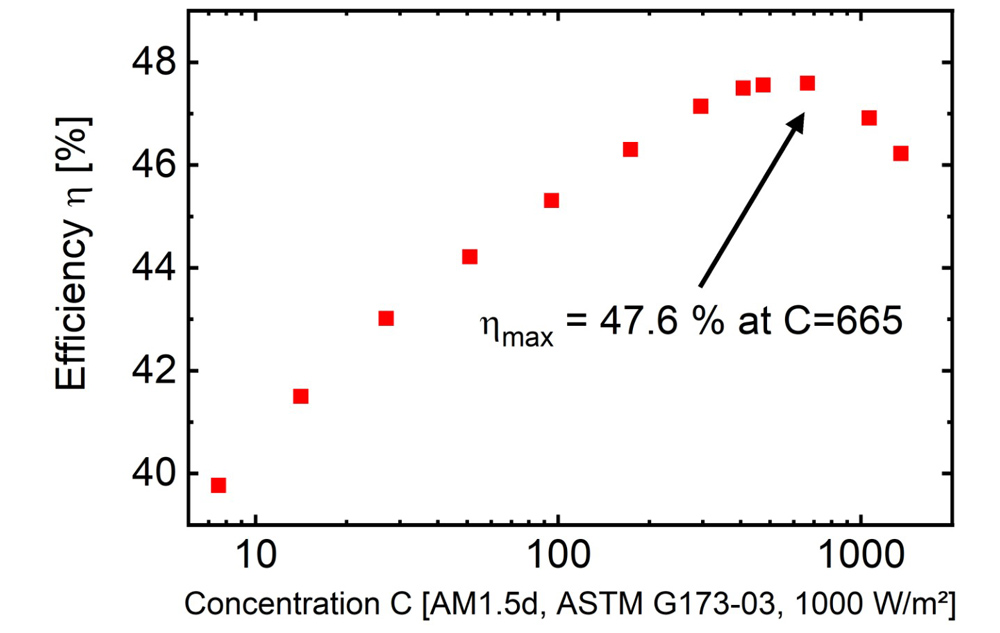News: Photovoltaics
30 May 2022
Fraunhofer ISE raises solar cell efficiency record from 46.1% to 47.6%
At the 2nd International tandemPV Workshop in Freiburg, Germany (30 May-1 June), Freiburg-based Fraunhofer Institute for Solar Energy Systems ISE has reported that, by using a new anti-reflection coating, it has increased the solar energy conversion efficiency of the best four-junction solar cell to date from 46.1% to 47.6% at a light concentration of 665 suns.
For the last two years, Fraunhofer ISE has been working on the project ‘50 Percent’, which - funded by the German Federal Ministry for Economic Affairs and Climate Action BMWK - aims to develop the first solar cell with efficiency of 50%. To achieve this, each individual layer of the complex multi-junction solar cell has undergone further optimization. Improvements in the process technology have been incorporated for metal contacts and anti-reflection layers.
The result was achieved only one year after the opening of Fraunhofer ISE’s new Center for High Efficiency Solar Cells, says Dr Frank Dimroth, department head of III-V Photovoltaics and Concentrator Technology at Fraunhofer ISE. “In our research, we aim to make concentrating photovoltaics even more efficient and competitive, as we believe that this is the most sustainable form of renewable electricity generation.”
Multi-junction solar cells made of III-V compound semiconductors have always been among the most efficient solar cells, and they reach their highest potential when the incoming sunlight is concentrated by lenses onto solar cell devices of just a few square millimeters in size.

Picture: Efficiency of the new four-junction solar cell increases with concentration up to 665 suns, reaching a record 47.6% conversion efficiency.
The layer structure of the new solar cell was developed in 2016 together with the French company Soitec Inc, which designs and manufactures semiconductor materials. The upper tandem solar cell is made of gallium indium phosphide (GaInP) and aluminum gallium arsenide (AlGaAs), which was bonded by Soitec onto a lower tandem solar cell made of gallium indium arsenide phosphide (GaInAsP) and gallium indium arsenide (GaInAs).
Now, in Fraunhofer ISE’s Center for High Efficiency Solar Cells, an improved contact layer and a four-layer anti-reflection coating have been applied to the tandem cell structure. These measures reduce the resistance losses and the reflection on the front side of the cell, which is spectrally sensitive within a broad wavelength range of 300-1780nm. Conventional solar cells made of silicon absorb sunlight only up to 1200nm and thus do not require such a broadband anti-reflection coating.

Picture: Quantum efficiency of the new four-junction solar cell. The top sub-cell made of GaInP absorbs short-wave sunlight in the visible spectral range. Infrared light is converted in the sub-cells beneath, which are made of AlGaAs, GaInAsP and GaInAs respectively.
“Possible applications of such highly efficient tandem solar cells include concentrator photovoltaic systems, which contribute to efficient power generation in sun-rich countries,” says professor Stefan Glunz, division director of Photovoltaics Research at Fraunhofer ISE. “With tandem photovoltaics, it is possible to leave the limitations of single-junction solar cells behind and ultimately achieve a reduction in solar power costs,” he adds.
Fraunhofer ISE inaugurates Center for High Efficiency Solar Cells
Fraunhofer ISE III-V multi-junction solar cells









